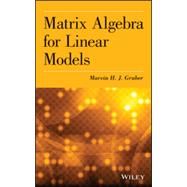A self-contained introduction to matrix analysis theory and applications in the field of statistics
Comprehensive in scope, Matrix Algebra for Linear Models offers a succinct summary of matrix theory and its related applications to statistics, especially linear models. The book provides a unified presentation of the mathematical properties and statistical applications of matrices in order to define and manipulate data.
Written for theoretical and applied statisticians, the book utilizes multiple numerical examples to illustrate key ideas, methods, and techniques crucial to understanding matrix algebra’s application in linear models. Matrix Algebra for Linear Models expertly balances concepts and methods allowing for a side-by-side presentation of matrix theory and its linear model applications. Including concise summaries on each topic, the book also features:
- Methods of deriving results from the properties of eigenvalues and the singular value decomposition
- Solutions to matrix optimization problems for obtaining more efficient biased estimators for parameters in linear regression models
- A section on the generalized singular value decomposition
- Multiple chapter exercises with selected answers to enhance understanding of the presented material
Matrix Algebra for Linear Models is an ideal textbook for advanced undergraduate and graduate-level courses on statistics, matrices, and linear algebra. The book is also an excellent reference for statisticians, engineers, economists, and readers interested in the linear statistical model.








